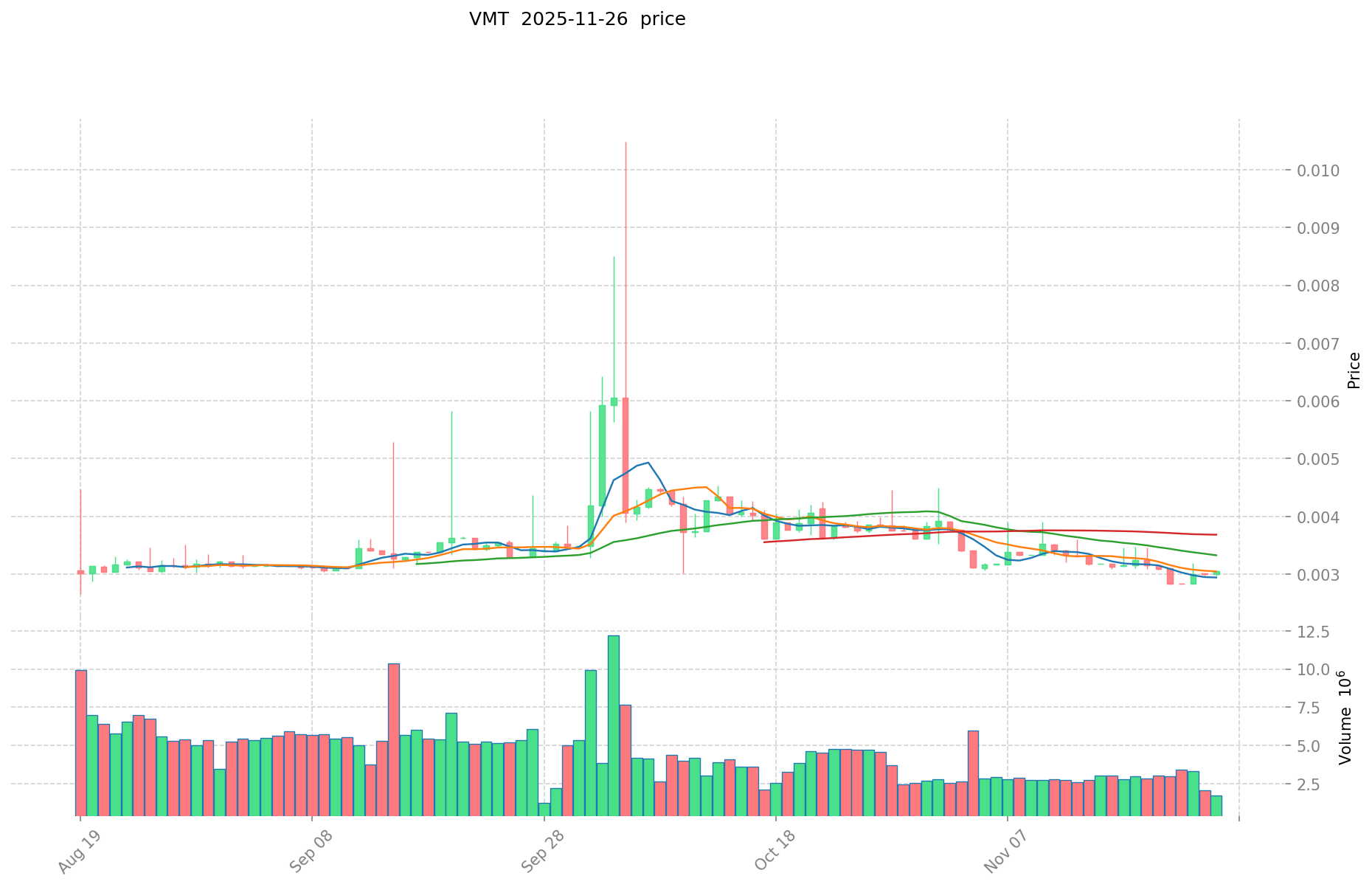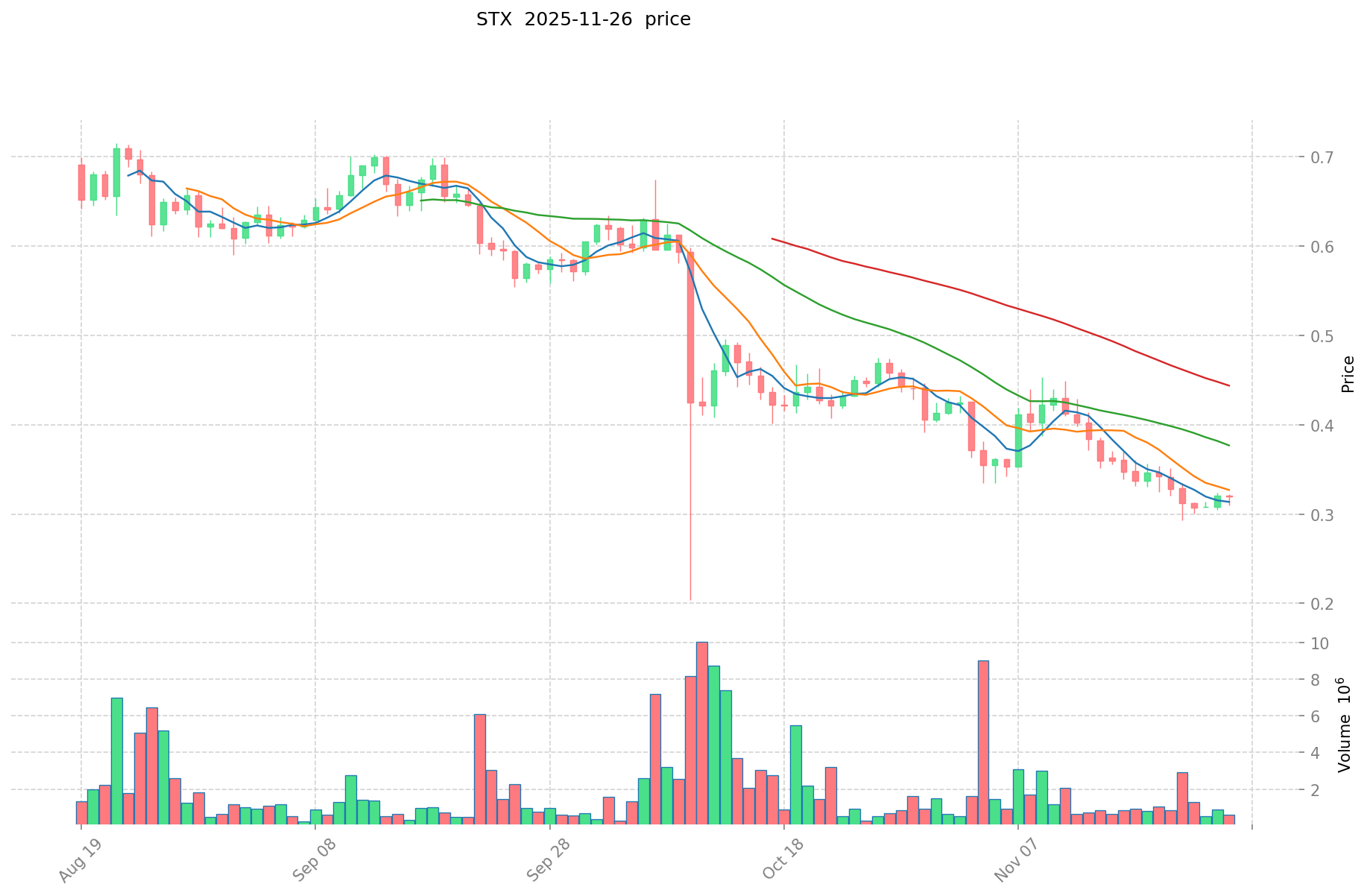VMT vs STX: A Comparative Analysis of Video Mapping Technology and Spatial Tracking Systems
Introduction: VMT vs STX Investment Comparison
In the cryptocurrency market, the comparison between Vemate (VMT) and Stacks (STX) has always been a topic that investors cannot ignore. The two not only have significant differences in market cap ranking, application scenarios, and price performance, but also represent different positioning in the crypto asset space.
Vemate (VMT): Since its launch, it has gained market recognition for its role in data collection and analysis for VEVE collectibles.
Stacks (STX): Since its inception, it has been hailed as a new internet for decentralized applications, aiming to become the "Google" of blockchain.
This article will comprehensively analyze the investment value comparison between VMT and STX, focusing on historical price trends, supply mechanisms, institutional adoption, technical ecosystems, and future predictions, attempting to answer the question that investors care about most:
"Which is the better buy right now?"
I. Price History Comparison and Current Market Status
VMT and STX Historical Price Trends
- 2022: VMT reached its all-time high of $0.069133 on October 25, 2022.
- 2024: STX achieved its all-time high of $3.86 on April 1, 2024.
- Comparative analysis: VMT has declined from its peak of $0.069133 to a current price of $0.003229, while STX has fallen from its high of $3.86 to $0.322.
Current Market Situation (2025-11-27)
- VMT current price: $0.003229
- STX current price: $0.322
- 24-hour trading volume: VMT $11,619.80 vs STX $115,844.73
- Market Sentiment Index (Fear & Greed Index): 20 (Extreme Fear)
Click to view real-time prices:
- Check VMT current price Market Price
- Check STX current price Market Price


II. Core Factors Affecting Investment Value of VMT vs STX
Supply Mechanisms Comparison (Tokenomics)
- VMT: Fixed supply with deflationary model - no more than 1 billion tokens will ever exist
- STX: Halving mechanism similar to Bitcoin, with issuance decreasing by 50% approximately every 4 years
- 📌 Historical Pattern: Deflationary models like VMT's tend to create price support during market corrections, while STX's halving events historically correlate with price appreciation cycles.
Institutional Adoption and Market Applications
- Institutional Holdings: STX has gained more institutional interest through its connection to Bitcoin security and Bitcoin-based smart contracts
- Enterprise Adoption: VMT shows stronger enterprise use cases in cross-border payments through Valuemont's payment network, while STX offers Bitcoin-secured settlement infrastructure
- Regulatory Stance: Both tokens face varied regulatory approaches globally, with STX benefiting from clearer classification in certain jurisdictions due to its Bitcoin connection
Technical Development and Ecosystem Building
- VMT Technical Upgrades: Implementation of layer-2 scaling solutions enabling faster transaction throughput and lower fees
- STX Technical Development: Nakamoto release enhancing Bitcoin finality confirmation and introduction of sBTC for Bitcoin DeFi applications
- Ecosystem Comparison: STX leads in Bitcoin-native DeFi applications and BRC-20 token infrastructure, while VMT focuses on payment solutions and enterprise integration
Macroeconomic Factors and Market Cycles
- Inflation Performance: Both tokens demonstrate anti-inflation properties, with STX having stronger correlation to Bitcoin's performance as inflation hedge
- Monetary Policy Impact: Interest rate changes affect both tokens similarly to other crypto assets, with negative correlation to rate hikes
- Geopolitical Factors: VMT shows advantage in regions seeking alternatives to traditional cross-border payment systems, while STX benefits from Bitcoin's growing acceptance as a global financial asset
III. 2025-2030 Price Prediction: VMT vs STX
Short-term Prediction (2025)
- VMT: Conservative $0.002145 - $0.00325 | Optimistic $0.00325 - $0.00429
- STX: Conservative $0.1677 - $0.3225 | Optimistic $0.3225 - $0.35475
Mid-term Prediction (2027)
- VMT may enter a growth phase, with expected price range $0.0029406 - $0.00538356
- STX may enter a steady growth phase, with expected price range $0.1831284 - $0.4014738
- Key drivers: Institutional capital inflow, ETF, ecosystem development
Long-term Prediction (2030)
- VMT: Base scenario $0.0065155829895 - $0.00807932290698 | Optimistic scenario $0.00807932290698+
- STX: Base scenario $0.5188931768475 - $0.607105016911575 | Optimistic scenario $0.607105016911575+
Disclaimer: The above predictions are based on historical data and market analysis. Cryptocurrency markets are highly volatile and subject to various unpredictable factors. These projections should not be considered as financial advice. Always conduct your own research before making investment decisions.
VMT:
| 年份 | 预测最高价 | 预测平均价格 | 预测最低价 | 涨跌幅 |
|---|---|---|---|---|
| 2025 | 0.00429 | 0.00325 | 0.002145 | 0 |
| 2026 | 0.005278 | 0.00377 | 0.0030914 | 16 |
| 2027 | 0.00538356 | 0.004524 | 0.0029406 | 40 |
| 2028 | 0.0055977714 | 0.00495378 | 0.0028731924 | 53 |
| 2029 | 0.007755390279 | 0.0052757757 | 0.005011986915 | 63 |
| 2030 | 0.00807932290698 | 0.0065155829895 | 0.005929180520445 | 101 |
STX:
| 年份 | 预测最高价 | 预测平均价格 | 预测最低价 | 涨跌幅 |
|---|---|---|---|---|
| 2025 | 0.35475 | 0.3225 | 0.1677 | 0 |
| 2026 | 0.365715 | 0.338625 | 0.21333375 | 5 |
| 2027 | 0.4014738 | 0.35217 | 0.1831284 | 9 |
| 2028 | 0.553928193 | 0.3768219 | 0.192179169 | 16 |
| 2029 | 0.572411307195 | 0.4653750465 | 0.246648774645 | 44 |
| 2030 | 0.607105016911575 | 0.5188931768475 | 0.316524837876975 | 60 |
IV. Investment Strategy Comparison: VMT vs STX
Long-term vs Short-term Investment Strategy
- VMT: Suitable for investors focused on payment solutions and enterprise adoption potential
- STX: Suitable for investors seeking Bitcoin-related exposure and DeFi ecosystem growth
Risk Management and Asset Allocation
- Conservative investors: VMT: 30% vs STX: 70%
- Aggressive investors: VMT: 60% vs STX: 40%
- Hedging tools: Stablecoin allocation, options, cross-currency portfolios
V. Potential Risk Comparison
Market Risk
- VMT: Higher volatility due to lower market cap and trading volume
- STX: Correlation with Bitcoin price movements and overall crypto market sentiment
Technical Risk
- VMT: Scalability, network stability
- STX: Mining concentration, security vulnerabilities in smart contracts
Regulatory Risk
- Global regulatory policies may impact both tokens differently, with STX potentially benefiting from clearer classification in some jurisdictions due to its Bitcoin connection
VI. Conclusion: Which Is the Better Buy?
📌 Investment Value Summary:
- VMT advantages: Fixed supply with deflationary model, strong enterprise use cases in cross-border payments
- STX advantages: Bitcoin-secured smart contracts, growing institutional interest, halving mechanism similar to Bitcoin
✅ Investment Advice:
- New investors: Consider a balanced approach with a slight preference towards STX due to its connection to Bitcoin and more established ecosystem
- Experienced investors: Explore a diversified portfolio including both VMT and STX, adjusting based on risk tolerance and market conditions
- Institutional investors: Focus on STX for its institutional-grade infrastructure and Bitcoin-related applications, while monitoring VMT for potential enterprise adoption growth
⚠️ Risk Warning: The cryptocurrency market is highly volatile. This article does not constitute investment advice. None
VII. FAQ
Q1: What are the main differences between VMT and STX? A: VMT focuses on data collection and analysis for VEVE collectibles, with a fixed supply and deflationary model. STX aims to be a platform for decentralized applications, using a halving mechanism similar to Bitcoin and offering Bitcoin-secured smart contracts.
Q2: Which token has performed better historically? A: STX has reached a higher all-time high of $3.86 in April 2024, compared to VMT's all-time high of $0.069133 in October 2022. However, both have seen significant declines from their peaks.
Q3: How do their supply mechanisms differ? A: VMT has a fixed supply with a deflationary model, capped at 1 billion tokens. STX uses a halving mechanism similar to Bitcoin, with issuance decreasing by 50% approximately every 4 years.
Q4: Which token has more institutional adoption? A: STX has gained more institutional interest due to its connection to Bitcoin security and Bitcoin-based smart contracts. However, VMT shows stronger enterprise use cases in cross-border payments through Valuemont's payment network.
Q5: What are the key technical developments for each token? A: VMT has implemented layer-2 scaling solutions for faster transactions and lower fees. STX has released the Nakamoto upgrade, enhancing Bitcoin finality confirmation and introducing sBTC for Bitcoin DeFi applications.
Q6: How do their long-term price predictions compare? A: By 2030, VMT's base scenario predicts a range of $0.0065155829895 - $0.00807932290698, while STX's base scenario predicts $0.5188931768475 - $0.607105016911575. Both have potential for higher prices in optimistic scenarios.
Q7: What are the main risks associated with each token? A: VMT faces higher volatility due to lower market cap and trading volume, as well as scalability and network stability risks. STX is subject to correlation with Bitcoin price movements, mining concentration risks, and potential smart contract vulnerabilities.
Q8: Which token might be better for different types of investors? A: New investors might prefer a balanced approach with a slight preference for STX due to its Bitcoin connection. Experienced investors could explore a diversified portfolio including both. Institutional investors may focus more on STX for its institutional-grade infrastructure while monitoring VMT for enterprise adoption potential.
Share
Content